What is wool? Wool is a natural textile fiber that is obtained from sheep and other animals that have woolly coats. It includes cashmere and mohair from goats, angora from rabbits and also qiviut from muskoxen.
The chemical structure of wool consists of protein and lipids so it is classified as a protein fiber. Thus, it is opposed to many other natural fibers (like cotton and linen) that are cellulose fibers.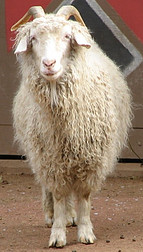
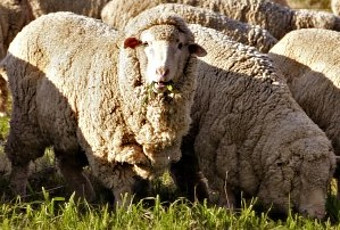
The wool that is commonly used in the textile industry comes from sheep. Sheep will be grown to produce meat, milk or wool (fiber).
There are about a hundred species of sheep that will produce fleece, but Merino is the breed that is widely raised for wool production. To understand what is wool, we need to look at the production of wool.
This post contains affiliate links and I will be compensated if you make a purchase after clicking on my links, without any additional cost to you. It helps me to maintain this website and bring you more eco friendly and sustainable news.
Wool Production
To produce wool, the first step would be to raise sheep and then shear them.
Shearing
Shearing of sheep is the process whereby the woolen fleece is cut from the sheep. This normally happens once a year during spring time. After shearing the wool is separated into four main categories: fleece, broken, bellies and locks, with fleece making up the vast bulk of the wool. Immediately after shearing the long fleece wool is separated from the short ones.
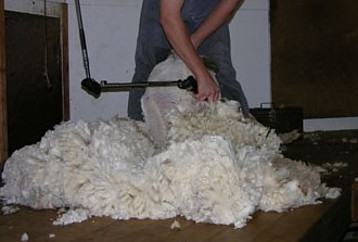
The fleece is classed according to the quality of the fleece and this is done by a wool classer, who groups wools of similar gradings together. Lambswool is the very first shearing from a lamb at around seven months old and produces very soft fine fibers.
A micron (micrometer) is the measurement used for the diameter of wool fiber. The diameter of the fiber is the most important characteristic in determining the value of the wool. The finer the wool fibers, the lower the micron value and therefor the higher the cost. Before Merino fleece wool is auctioned in Australia, it is measured for micron, yield, staple length and staple strength and sometimes also for colour.
Two main manufacturing methods or systems are used to produce yarns and fabrics: the worsted system or the woollen system.
- The worsted system uses the long fibers and produces smoother yarns and therefore smoother fabrics.
- The woollen system uses the short fibers and produces yarns that are rougher and the fabric has a hairy or raised appearance
Scouring
Wool that has come straight off a sheep is known as “greasy wool” or “wool in the grease”.The greasy wool needs to be cleaned before it can be used for commercial purposes. The process of cleaning the greasy wool is called scouring. Greasy wool contains a high level of valuable lanolin, as well as the dead skin and sweat residue from the sheep. Usually it also contains pesticides and vegetable matter from the animal’s environment.
Many impurities are found in raw wool including dirt, sand, vegetable matter and a mixture of sweat, grease, urine stains and dung locks.
Many types of wool with different strengths, thicknesses, staple length and impurities will come from a sheep. The raw greasy wool is processed into “top”. “Worsted top” requires straight, parallel and strong fibers.
Scouring may be a simple process of washing it in warm water or a complicated industrial process using detergent and alkali in specialized equipment. Industrial scouring involves the greasy wool being put in a series of washing bowls, normally 6 to 8 bowls. The first 2 or 3 bowls will have warm water and detergent and sometimes also an alkali. During these washes most water-soluble substances are removed. Then follows 3 to 5 bowls of rinsing.
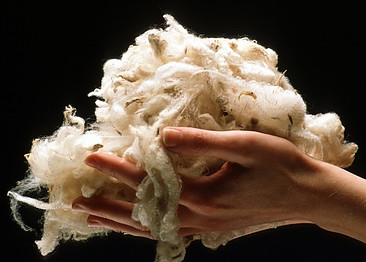
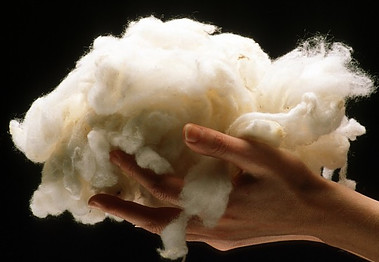
The vegetable matter in commercial wool is often removed by chemical carbonization, which is the conversion of organic matter into carbon. In hand produced or less-processed wools, the vegetable matter may be removed by hand and through using gentler detergents, some lanolin will be left in the wool. Lanolin removed from wool is widely used in the cosmetic industry for products such as hand creams.
The scoured lose wool then goes into a continuous drier. Afterwards the wool is then mechanically beaten to remove insoluble substances, like sand and dust. At the end of scouring almost all the different contaminants should have been removed from the greasy wool.
Next the wool is pneumatically transported into a closed room known as a bin. There it is blended and left to condition until the moisture content reaches equilibrium.
The next stage of manufacturing is known as top-making.
Top-making
Top-making is unique to the worsted method of manufacturing and is not used in the woollen system. There are three mains steps involved namely carding, gilling and combing, which are all methods that prepare the fiber for spinning.
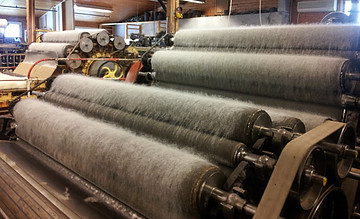
1. Carding is a mechanical process whereby fibers are separated and knots and tangles are removed from the fibers. A carding machine consist of sets of drum rollers with tiny teeth and it aligns the fibers to be parallel for spinning. Short fibers, called noils, are also removed during carding.
Carding will remove as much as possible of any remaining contaminants, forming a homogeneous web of weight per area. This web will then be formed into a continuous length of fiber known as a card sliver. Carding can also be done by hand with square or rectangular paddles. Hand spinners will sometimes card their own wool and this can be done with “greasy wool”, depending on the spinner’s preferences.
2. Gilling is the process of attenuating worsted fibers and making them parallel. Gilling ensures further alignments of the fibers and further blending of wool. It also ensures that hook shaped fibers are in the best direction and it evens out the linear weight of the carded sliver. A gilling machine have two sets of rotating rollers with a bed of moving pinned combs between the front and back roller. The slivers are drawn through the bed of moving combs by the rollers, resulting a single sliver coming out of the machine.
3. Combing Wool is combed only in the worsted method of manufacturing and will be combed twice (known as re-combing) in the production of fine wool yarns. Combing is divided into linear and circular combing and it separates out short fibers by means of a rotating ring or a rectilinear row of steel pins. The long fibers that are left are called tops and the short fibers are called noils. The noils are removed and also small clusters of fibers, called neps. Combing will also remove any traces of seeds or burs that might be left. A combing machine have a series of fine combs through which the fibers are brushed, resulting in a combed sliver.
The combed sliver undergoes a series of gilling again and then drawing, by passing it through a roving machine.
The final stages of wool production is spinning and finally weaving if it is being used for textiles.
Luxury Wool fibers
Mohair comes from the angora goat whereas cashmere comes from the cashmere goat. Mohair and cashmere are both different from angora hair or angora fiber, which comes from the downy coat of the angora rabbit. Angora fiber is known for it’s thin fibers, softness and silky texture and knitters often refer to the fluffiness of the wool as a “halo”. The angora fiber has a hollow core, making it much warmer and lighter than wool.
 Angora rabbits can produce coats in different colours from white through tan, gray, brown and black. Good quality angora fiber is around 12–16 micrometres in diameter, and can cost as much as $10–16 per ounce (35 to 50 cents/gram). The animal itself needs to be groomed frequently as the hair felts or matts very easily.
Angora rabbits can produce coats in different colours from white through tan, gray, brown and black. Good quality angora fiber is around 12–16 micrometres in diameter, and can cost as much as $10–16 per ounce (35 to 50 cents/gram). The animal itself needs to be groomed frequently as the hair felts or matts very easily.
The cost of 100% angora fiber is high so it is often used as accents. They have the most warmth and fluffiness, but can easily felt through abrasion and humidity and can be excessively warm in a finished garment.
Angora fiber is not naturally elastic so the fiber is often blended with wool to give the yarn elasticity. The wool/angora blend decreases the softness and halo, as well as the price of the finished object. Commercial knitting yarns is typically produced using 30–50% angora, in order to produce some halo, warmth, and softness without the side effects of excessive felting.
Properties of Wool
- Wool fiber is hygroscopic which means it atttracts moisture. Wool draws moisture away from the body and absorbs it inside the fiber. Heat is generated as the moisture is absorbed so the garment stays warm without feeling clammy.
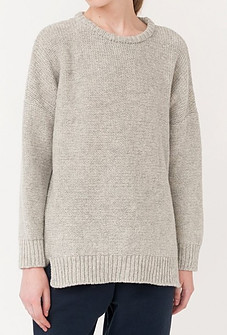
- Because of its hygroscopic properties, wool is a very good insulator, it allows your skin to breath.
- Wool is naturally water repellant. The outer layer of wool fibers have scales making it hydrophobic, meaning it repels water.
- These outer scales also make it difficult for dirt and dust to penetrate. Stains sit on top of the fibers rather than being absorbed by them, making it stain resitant and easier to clean than many other fibers.
- Wool is fire resistant. It will not burn easily and will smoulder rather than burst into flames. It doesn’t melt and stick to your skin like synthetic fibers making it ideal for blankets and carpets and also uniforms for firefighters.
- Wool absorbs moisture from the air thus reducing the potential of static electricity building up in the fabric.
- It is durable. Wool is a hardwearing fiber that will retain it’s good appearance for a long time if it is looked after.
- Wool absorbs odours.
The properties of wool make it perfect for use in clothing, blankets, carpets, upholstery, horserugs and saddlebags. It is also used for insulation.
Final Thoughts On Sustainable Wool
Organic wool is becoming more and more popular but it is still limited in supply. Much of it comes from New Zealand and Australia. It is being used by Allbirds, to create waterproof shoes and sustainable wool garments. Read more in this related post about Best Sustainable shoes from Allbirds.
Related post that you will find interesting on the use of sustainable and recycled wool in clothing: 7 Best Sustainable wool sweaters that keep the planet happy.
If you have any comments or question, please leave them below and I’ll get back to you.
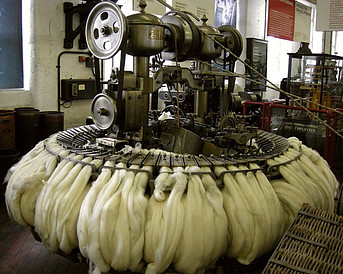

Hi, this was a really interesting read!
Wool is FIRE proof?
So like, if I had a wool comforter on my bed and my house caught on fire but I didn’t wake up, would I still be there the next day?
Do they have wool onesies where you can just be covered in wool like a human lamb?
I don’t know this was interesting I might have to look more into wool now.
Maybe superman should have a cape made out of wool!
Hi Justin, Just to correct you, wool is naturally fire RESISTANT, which means that it will not easily burn, and when it does, it will smoulder rather than burst into flames. (You might want to read the section on properties of wool again). Onesies for babies and kids are available, so you will find somebody will make bigger sizes.
Wow I had no idea about all of this. I simply thought will came from sheep and that was it.
I never even considered to think there were different kinds of sheep’s or that wool could come from different types of animals.
Would you say that wool is the best quality for keeping someone warm? Also if not, would you say it’s one of the cheapest things you can buy to keep you warm?
Hi Michael, wool is certainly one of the best natural fibers to keep you warm, but it is not necessarily the cheapest fiber. Synthetic man made fibers are usually cheaper, but it is like wrapping your body in plastic, which I don’t like as there is not circulation of air around your body.
Wool will last you many years if you look after it, and it is worth the extra bit of money that you might need to pay for that natural wool jumper. I hope this has answered your questions but please let me know if you need more help.
Hi Line,
Thank you for this informative article. I have now have a better knowledge about wool. I wasn’t aware than wool is fire resistant , water repellent or that it absorbs odours.
I heard the word Mohair many times when I was young , but I never knew that the material comes from angora goat, I always thought it is a synthetic material.
Thank you again for all the information shared with us
Kind regards,
Yoana
Hi Yoana, I am very pleased to hear that you found the article on wool so informative. Mohair is indeed a beautiful natural fiber and lovely and soft next to the skin.
I really enjoyed reading this article on wool and how it is produced! I had no idea what is involved and how many desirable properties wool has. No wonder it is such a common fabric in socks! I have a few pairs of wool socks and they are amazingly comfortable in the winter months. I did not realize that wool is a water repellant as well as fire resistant. I also learned that firemans coats are made of wool and that makes a lot of sense. Very informative article!
Hi Dave, I am pleased to hear that you found the article informative. Wool has a load of great natural properties and I love wearing it. Wool socks will certainly keep your feet nice and warm, without restricting the circulation of air. Cotton and bamboo are also used in socks, which are cooler to wear in hot climates.
When I was in New Zealand, I got the opportunity to observe a man sheering the wool from the sheep. I was impressed! He was so quick, the sheep looked confused the whole time and just like that minutes later the sheep was naked and so skinny! I assume that they are fat but all of that is just their fur lol Wow I had no idea that it takes so many process to make wool wearable! And is such a thing as cashmere goat? I learn something everyday lol The angora goat is so adorable by the way. Now that I know all these process I can appreciate my wool sweater more and stay warm as well 🙂
Hi Nuttanee, it is indeed fascinating to see sheep being sheered, I can remember that from being a child as well. And when you then touch that raw wool, it is actually very dirty and quite fatty with the natural lanolin. I prefer wearing wool and other natural fibers, as my body can breathe, so I am pleased to hear that you have learnt something new.
Superwash means that the fiber is either dipped in a chemical to remove the scales or coated with plastic. Neither are very good just to be able to put through the washing machine . The particles of plastic that are released with every wash get into the water system and are killing the water life. Wean yourself from plastics. Use pure natural fibers. Use a natural ‘superwash’ like a Down breed of wool that can go in the machine without felting.
I completely agree with you Dianne, plastic is a huge pollutant and killing our sea life. Most people do not realise that plastic particles are released during the washing process. Natural fibers are certainly the way to go and organic is even better.
Hi there,
Your article is very enlightening. You highlight the important role played by the commercial farmers in growing the economy. It is amazing to learn the about the whole process, from shearing to the end products.
South Africa also supply and export wool. I grew up in the Eastern Cape, South Africa. My grandfather had about two hundred stock, goats and sheep. Selling wool was his source of income, and to him shearing was a skill. I realized then that there was a lot of careting involved to ensure that good quality wool is produced.
I enjoyed goat milk with Joko tea, and my grandmother’s fat cakes – sitting around a Welcome Dover stove.
South Africa certainly produces some lovely wool and mohair and makes up 1% of world wool production. Australia is the biggest producer of wool supplying around 25% of world production. China, New Zealand and USA are the other biggest producers. I can still remember watching the shearing process when I was a child in South Africa and was amazed by the skill that the shearer had.
Well, this certainly was very educational, Liné! I truly never knew how much processing went into making my wool sweaters!
After reading this, I now understand that the wool in my sweaters must have been manufactured using the woolen manufacturing system – because, they are a little itchy and scratchy if worn next to my skin.
I was a bit shocked to learn of all the extra dirty elements that are present in raw wool. Not only vegetable matter – but, urine – and feces? But, it is heartening to know that such an extensive cleaning process – scouring – is used to turn the “greasy wool” into usable yarn.
I may be guessing – but, my wool socks probably come from yarn produced through the worsted manufacturing process – since they are much softer and don’t cause my feet to itch. Am I right?
It’s great that I can clean my wool socks by running them through a washing machine and dryer without harming them. But, the same is not true with my wool sweaters. Can I assume that the reason for this is that the socks most likely have additional “non-wool” fibers that give them added strength and durability – so they can survive a more intense cleaning method?
Jim
Hi Jim, your socks might have gone through a process called “Superwash” which will make the wool washable. Washing your sweater with fabric softener might help to reduce the itchiness. Look out for the “machine washable” label in sweaters next time you buy a new jersey as not all of them would be machine washable. I actually never wash them at more than 20°C and reduce the spin speed to around 400rpm as excess spinning might cause felting.
Superwash means that the fiber is either dipped in a chemical to remove the scales or coated with plastic. Neither are very good just to be able to put through the washing machine . The particles of plastic that are released with every wash get into the water system and are killing the water life. Wean yourself from plastics. Use pure natural fibers. Use a natural ‘superwash’ like a Dow
n breed of wool that can go in the machine without felting.
Natural fibers are by far the best and much nicer to wear as well. It is not only the temperature that can cause felting but also agitation, rubbing, wringing and spinning.